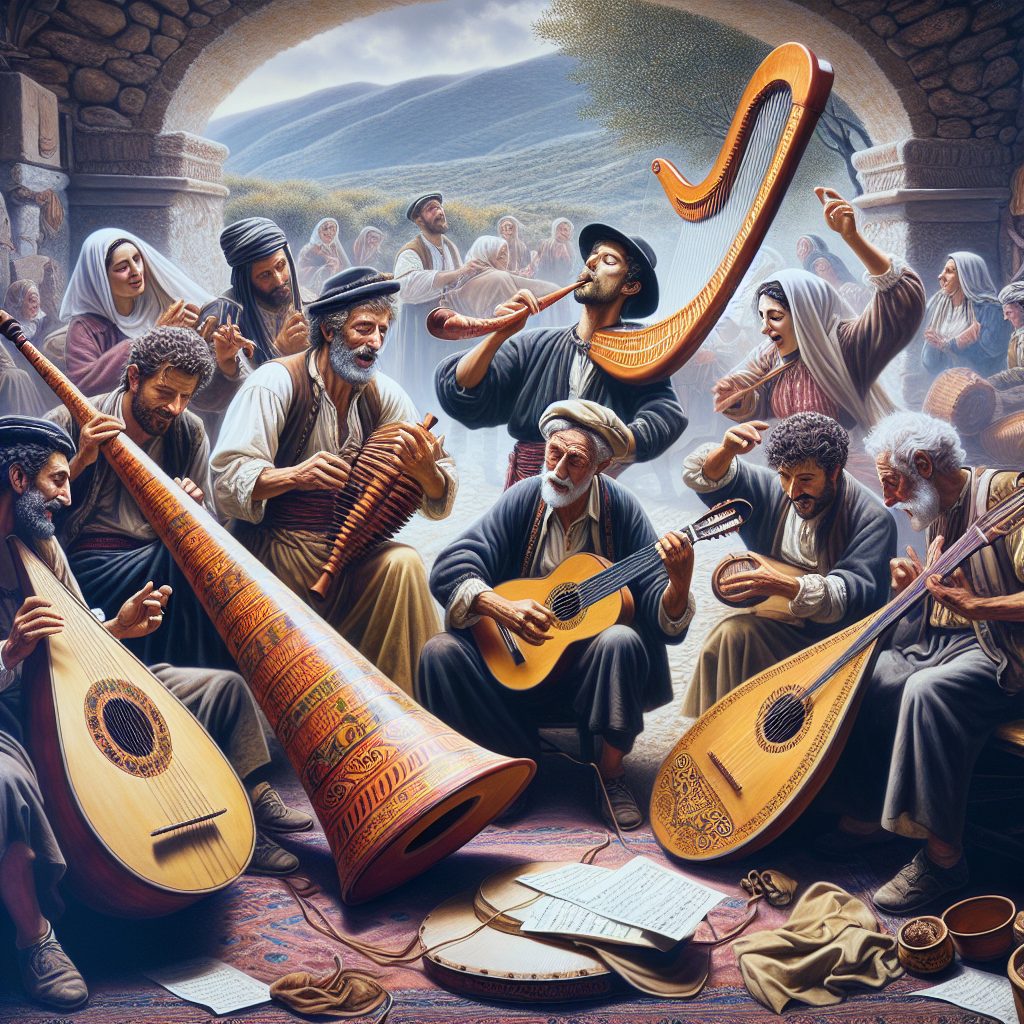Sardinian music history encompasses a rich tapestry of unique traditions and vibrant cultural influences. Defined by its distinctiveness and diversity, Sardinian music is a testament to the island’s rich heritage and strong sense of identity. With roots that trace back thousands of years, this captivating musical tradition not only reflects the island’s breathtaking landscapes but also serves as a channel for storytelling and community bonding.
The impact of Sardinian music is deeply ingrained in the island’s social fabric, with each song and melody reflecting the shared experiences and historically significant events of its people. One of the most remarkable features of Sardinian music is its preservation of ancient, pre-Roman musical styles. This is particularly evident in the captivating polyphonic singing, known as “cantu a tenore.” This mesmerizing vocal technique, characterized by distinctive harmonies and haunting melodies, has been recognized by UNESCO as an Intangible Cultural Heritage of Humanity. Beyond its great historical importance, Sardinian music’s enduring presence in the modern era highlights the island’s commitment to preserving and celebrating its unique cultural heritage.
In the upcoming section, we will delve into the key takeaways of Sardinian music history. We will explore the various musical genres and traditions that have shaped this captivating art form over the years. From the rhythmic sounds of “launeddas,” the ancient Sardinian woodwind instrument, to the captivating dance tunes of the “tarantella,” we will uncover the wealth of musical expressions that have emerged from this small Mediterranean island. Additionally, we will examine the significance of Sardinian music in contemporary society, discussing its influence on the island’s tourism industry and the continued efforts to safeguard and promote this invaluable cultural heritage.
Key Takeaways
1. Sardinian music has a rich history dating back thousands of years, with influences from various civilizations, and its distinctiveness is attributed to its isolation and unique cultural heritage.
2. The traditional music of Sardinia is characterized by its polyphonic and improvisational nature, often performed by groups of singers using an ancient vocal technique called cantu a tenore, which creates mesmerizing harmonies.
3. The island’s music traditions also include the launeddas, an ancient triple pipe that produces haunting sounds, the tamburinos, and the Spanish-influenced guitar-like instrument called the chitarra sarda.
4. Throughout history, Sardinian music has served as a way to express and preserve the island’s cultural identity, with songs addressing themes such as pastoral life, love, social issues, and historical events.
5. Despite facing challenges of modernization and globalization, Sardinian music continues to thrive and evolve, with contemporary artists incorporating traditional elements into modern genres, keeping the island’s musical heritage alive.
What is the Rich and Colorful History of Sardinian Music?
The Origins of Sardinian Music
Sardinian music has a deep-rooted history that dates back centuries. It is influenced by various cultures, including the indigenous Nuragic civilization, as well as Phoenician, Carthaginian, Roman, Byzantine, and Spanish civilizations. These diverse influences have shaped and contributed to the unique musical traditions found in Sardinia.
Vocal Traditions
One significant aspect of Sardinian music is its vocal traditions. The island is known for its polyphonic singing, with multiple voices harmonizing to create intricate melodies. There are various vocal styles, including cantu a tenore, which is performed by four male singers using unique vocal techniques and harmonies. Another popular style is cantu a chiterra, featuring singing accompanied by a guitar-like instrument known as the chitarra sarda.
Instrumental Traditions
Sardinia also has a rich instrumental tradition. The launeddas, a triple pipe instrument, is one of the most iconic symbols of Sardinian music. It is believed to have originated from ancient pastoral traditions and is still played today, producing haunting melodies that are characteristic of the island’s music. Other traditional instruments include the guitar-like chitarra sarda, the accordion, and the organetto.
Regional Variations
Sardinian music is not a homogenous entity but rather showcases regional variations. Each region within Sardinia has its own distinct musical styles and traditions. For example, the northwestern coastal regions are influenced by ancient maritime cultures, while the mountainous interior regions have unique pastoral and folk traditions. These regional variations add depth and diversity to Sardinian music.
Modern Developments
While Sardinian music has deep roots in tradition, it has also evolved and adapted to modern influences. Contemporary artists blend traditional Sardinian elements with other music genres, including pop, rock, and jazz. This fusion has not only preserved the heritage of Sardinian music but also made it accessible to wider audiences both within and outside of Sardinia.
Preserving Sardinian Music Heritage
As Sardinia embraces modernity, efforts are being made to preserve and promote the island’s musical heritage. Numerous festivals, events, and organizations are dedicated to showcasing Sardinian music, ensuring its continued appreciation and recognition. It is through these initiatives that the unique and captivating sounds of Sardinian music will endure for future generations.
Guides to Explore Sardinian Music History:
1. How can I attend traditional Sardinian music festivals and events?
2. What are the essential albums or recordings to explore Sardinian music?
3. Are there any notable Sardinian musicians or bands I should listen to?
4. Where can I learn more about the history and cultural significance of Sardinian music?
5. How can I support the preservation of Sardinian music heritage?
FAQ
1. What is Sardinian music?
Sardinian music refers to the traditional music of the island of Sardinia, located in the Mediterranean. It is characterized by a rich cultural heritage influenced by various civilizations throughout history.
2. What are the main traditional instruments used in Sardinian music?
The main traditional instruments used in Sardinian music include the launeddas (a triple-piped reed instrument), the guitarra (a small guitar-like instrument), the accordeon, the organetto, and the tamburello (a type of frame drum).
3. What are the different genres of Sardinian music?
Sardinian music encompasses a range of genres, including cantu a chiterra (guitar songs), cantu a tenore (polyphonic vocal music), ballu tundu (circle dance), ballu sardu (Sardinian dance), and gosos (religious songs).
4. How has Sardinian music been influenced by other cultures?
Over centuries, Sardinian music has been influenced by Phoenician, Roman, Byzantine, Spanish, and Italian cultures. Each has contributed to the unique sound and style of Sardinian music.
5. Are there any famous Sardinian musicians?
Absolutely! Notable Sardinian musicians include Maria Carta, Elena Ledda, Paolo Fresu, Efisio Melis, Luigi Lai, and Antonello Salis. These artists have gained recognition for preserving and promoting the rich musical heritage of Sardinia.
6. Is Sardinian music only performed at traditional festivals?
No, Sardinian music is not limited to traditional festivals. It can be enjoyed throughout the year at various concerts, cultural events, and even in recordings. Many talented Sardinian musicians also incorporate modern influences in their music.
7. Are there any similarities between Sardinian music and other Mediterranean music traditions?
Yes, there are some similarities between Sardinian music and other Mediterranean music traditions, especially with regards to the use of modal scales, ornamentation techniques, and vocal styles. However, Sardinian music has its distinct identity and charm.
8. Can I learn to play Sardinian music instruments?
Yes, there are resources available for learning to play Sardinian music instruments. Local music schools, workshops, online tutorials, and sheet music can help you get started on your journey to mastering the unique sounds of Sardinian music.
9. How can I experience Sardinian music firsthand?
If you have the opportunity to visit Sardinia, attending traditional festivals, concerts, and cultural events is a great way to experience Sardinian music firsthand. You can also explore local music venues or seek out recordings and performances by Sardinian musicians.
10. Is Sardinian music in danger of disappearing?
While globalization and changing cultural dynamics pose some challenges, efforts are being made to preserve and promote Sardinian music. The passion and dedication of musicians, cultural organizations, and the local community play a crucial role in ensuring the longevity of Sardinian musical traditions.
Final Thoughts
Sardinian music is a treasure trove of cultural history and artistic expression. Its unique blend of influences and distinctive styles make it a fascinating and compelling genre of music. By exploring the rich traditions, engaging with talented Sardinian musicians, and supporting efforts to preserve and promote this musical heritage, we can contribute to its continued vitality and enchantment for generations to come.
Immerse yourself in the captivating sounds of Sardinian music, and let it transport you to the vibrant landscapes and rich history of this beautiful island. Through its melodies, rhythms, and heartfelt lyrics, Sardinian music offers a captivating experience that speaks to the soul and leaves a lasting impression. Discover the magic of Sardinian music and embark on a journey of cultural exploration like no other.






